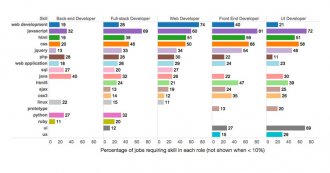
Navigating the funhouse that is a web development job board can make anyone question his or her sanity. Where one posting presents a concise list of required skills, another seems to catalog every skill, program, framework, and platform in existence. To further complicate matters, there is still widespread confusion as to what constitutes a specific role. A front-end developer, for example, is often seen as interchangeable with a UI developer, even though the two roles do differ in some respects.
The lack of consensus when it comes to web development roles and skills might have something to do with the industry’s rapid evolution. New technology requires new skills, and new skills call for new roles.
To help distinguish between the different web development roles, Sundeep Pattem and Olivia Zhao, SkilledUp’s resident data scientists, conducted a study of over 28 million online job postings from the period of May 2013 to September 2014. Their findings painted a much clearer picture of the relationship between web development roles and web development skills.

Front-end Developer
Alternative titles: Front End Web Developer, HTML Developer
A front-end developer specializes in building the front end, or client-side, of a web application, which encompasses everything that a client, or user, sees and interacts with. Front-end development is all about what’s visible to the user. For instance, the interface displaying these very words resides on the front end of SkilledUp’s website.
According to Pattem and Zhao’s study, the three most coveted front-end development skills are JavaScript, CSS, and HTML. However, this is true for four out of the five web development roles, as JavaScript, CSS, and HTML have always been staples of the industry. If we move beyond the top three, the results grow more refined..
[cm:2805]
Pattem and Zhao found that employers tend to look for front-end developers with a strong command of HTML5 and CSS3. As more and more focus is being placed on rich, interactive web applications, the latest incarnations of HTML and CSS are necessary additions to a front-end developer’s toolbox.
Back-end Developer
Alternative titles: Backend Engineer, Backend Software Developer
A back-end developer is responsible for building and maintaining the back end, or server-side, of a web application, which includes the server, the application, and the database. Back-end development is all about what’s invisible to the user. It’s what happens behind the scenes to display the words you’re reading right now.
INTERESTING VIDEO












